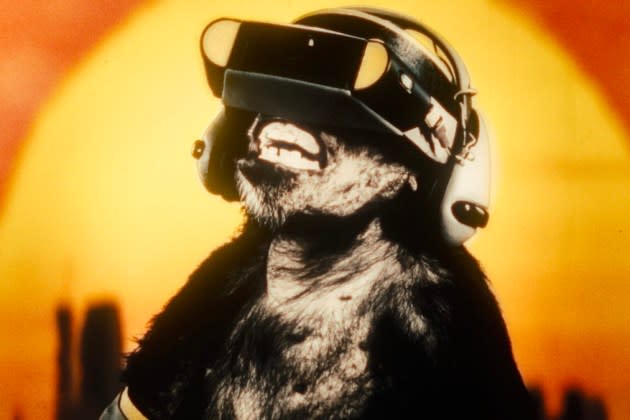‘Once Within a Time’ Review: An Inventive, Kid-Friendly Short From the Mind Behind ‘Koyaanisqatsi’
- Oops!Something went wrong.Please try again later.
- Oops!Something went wrong.Please try again later.
- Oops!Something went wrong.Please try again later.
- Oops!Something went wrong.Please try again later.

Godfrey Reggio, creator of the Qatsi trilogy, has been down this road before. The obsessions are familiar — nature’s innocence corrupted by industry, technology and the atomic age — but the audience is presumably different. This time, it’s younger. Now in his 80s, the avant-garde filmmaker who, in collaboration with composer Philip Glass, found a new cinematic language to caution people of their impact on the environment, has now turned his attention to kids.
With “Once Within a Time,” Reggio communicates his fears about the pitfalls of progress to the generation he’s counting on to fix the messes grown-ups have made of this hand-me-down planet, using circus-trained acrobats, a next-dimension soundtrack and Mike Tyson (of all things) to get his message across. At well under an hour (just 43 minutes before credits), the project presumes a different attention span than the ex-monk’s groundbreaking 1982 essay film, “Koyaanisqatsi,” which used slow-motion, time-lapse and other pace-based tricks in ways that influenced everything from music videos to Terrence Malick movies.
More from Variety
After the theatrical parting of red velvet curtains, Reggio’s latest project — co-directed by DJ-turned-video-artist Jon Kane — opens with an anthropomorphic Tree of Life (Sussan Deyhim), who sways her branches as she lip-syncs an otherworldly chant. The music for Reggio’s films has always been an integral dimension of their meditative, mind-expanding potential, and this latest collaboration invites fresh experimentation from Glass, who shifts from Indigenous song to a carnival calliope, incorporating everything from the cheering of totalitarian crowds to the beeps and boops of emerging digital technology.
Way back in 2002, I remember feeling that the last of the Qatsi movies, “Naqoyqatsi,” hadn’t kept up with the visual effects seen everywhere from TV commercials to studio movies, which gave the entire project the feel of being behind the times. Reggio wisely embraces a retro, midcentury dystopian vision here, running the footage through a process that makes it look like hand-tinted 16mm film, battered and scratched by decades of use.
There’s an appealing lo-fi quality to it all, as Reggio and Kane resist the sharp, hyper-digital look of contemporary CGI, leaning on vintage trompe l’oeil effects instead: double exposure, rear projection and forced-perspective gags involving scale models (with credit owed production designer Scott Pask and costume revolutionary Machine Dazzle). Much of this is no doubt achieved using newer tools, but the result appears appealingly old-school. The title indicates that this isn’t some long-ago fairy tale, but a parable about the present, even if the style lands somewhere between silent films and midcentury Soviet propaganda movies.
Early on, a “Nonsense Man” (Brian Belott, dressed as a giant red apple) waddles onto a children’s playground and opens a panel on his chest to reveal a Buster Keaton-esque character (John Flax) who represents … what? The apple isn’t just the fruit of forbidden knowledge for the suspenders-wearing boy (Apollo Garcia Orellana) and gingham-clad schoolgirl (Tara Starling Khozein) who wander over to investigate; it’s also the symbol of the tech company whose pocket-sized personal computer — misleadingly marketed as a “phone” — occupies an alarming amount of young people’s attention today.
No wonder Reggio presents these screens as looming black panels, reminiscent of the obelisk in Stanley Kubrick’s “2001: A Space Odyssey.” In one of the film’s many indelible images, wolves howl at the base of a smartphone, while a rocket pierces the eye of George Méliès’ moon on its gigantic screen. Is this some kind of warning? That’s for viewers to decide, represented here by an assortment of kids who stare directly into the camera, a strategy Reggio developed on 2013’s “Visitors.” There’s a lot to process, from mushroom clouds and dancing robots to flying saucers and a chimpanzee in a virtual-reality headset.
I refuse to accept that Reggio is anti-technology, considering that his filmography has so often leaned on innovative tools. But he’s right to be wary of it. “Once Within a Time” invites young people to question the systems they’re confronted with in the real world, from politics (Belott reappears as a looming dictator, beamed into a giant panopticon) to electronics (represented by an army of Teletubbies-style emoji characters). The solution? That’s where Mike Tyson comes in, playing “The Mentor,” a distracting Mr. T-like figure who gathers a crowd of children and gives them the motivational speech they need to liberate themselves — though all that comes out of his mouth is squeaky percussion and horns.
Will kids connect with Reggio’s message? I’d wager they will, thanks to the introduction of an element we don’t typically associate with the Qatsi movies: humor. From the physicality of the performances (especially that of Garcia Orellana, who embodies at least four characters, and emcee Flax with his oversized fake teeth) to the comical counterpoint the music and sound effects provide, the short film delightfully blends classic clowning with a multimedia dance show. Ultimately more optimistic than alarmist, Reggio leaves the “happily ever after” for his young audience to determine.
Best of Variety
Sign up for Variety’s Newsletter. For the latest news, follow us on Facebook, Twitter, and Instagram.
